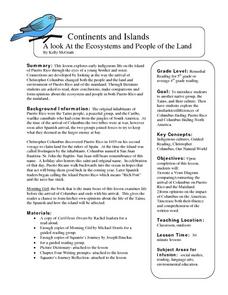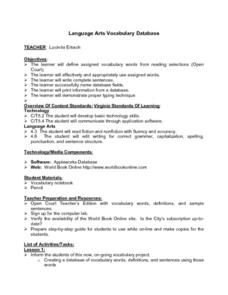EngageNY
Solve for Unknown Angles—Angles and Lines at a Point
How do you solve for an unknown angle? In this sixth installment of a 36-part series, young mathematicians use concepts learned in middle school geometry to set up and solve linear equations to find angle measures.
EngageNY
Solving Logarithmic Equations
Of course you're going to be solving an equation—it's algebra class after all. The 14th installment of a 35-part module first has pupils converting logarithmic equations into equivalent exponential equations. The conversion allows for...
EngageNY
The Graph of the Natural Logarithm Function
If two is company and three's a crowd, then what's e? Scholars observe how changes in the base affect the graph of a logarithmic function. They then graph the natural logarithm function and learn that all logarithmic functions can be...
EngageNY
Representing, Naming, and Evaluating Functions (Part 2)
Notation in mathematics can be intimidating. Use this instructional activity to expose pupils to the various ways of representing a function and the accompanying notation. The material also addresses the importance of including a domain...
EngageNY
Graphs of Linear Functions and Rate of Change
Discover an important property of linear functions. Learners use the slope formula to calculate the rates of change of linear functions. They find that linear functions have constant rates of change and use this property to determine if...
EngageNY
Simplifying Square Roots
Explore the process of simplifying square roots through an analysis of perfect squares. The fourth lesson of 25 expects individuals to find the perfect square factors in each radicand as a means of simplifying. The perfect square factor...
EngageNY
The Relationship of Multiplication and Division
Take any number, multiply it by five, and then divide by five. Did you end up with the original number? In the same vein as the previous lesson, pupils discover the relationship between multiplication and division. They develop the...
Curated OER
Friendly Patter Poetry
Students create a free from poem on the topic of friendship. They read examples of free form poetry to gather ideas. Through the use of a graphic organizer, students generate a list of friendship characteristics which is used to create...
Curated OER
Can you Top That?
Students make connections between their own experiences and the story, "get" the author's message and be able to discuss it with other readers, and apply their reading skills and strategies. They predict what happens in the story,...
Curated OER
Leo and the Butterflies
Second graders read a book entitled, "Leo and the Butterflies." They discuss the rainforest and butterflies. Students observe the pictures and predict what will happen in the story. They examine reading strategies for decoding unfamiliar...
Curated OER
Other Faces of Discrimination
High schoolers explore the bullying experienced by those who graduated from one-room school houses to large high schools. In this discrimination lesson, students read the 2 provided handouts on the topic and then complete the included...
Curated OER
Ready, Set, Action
Young scholars identify propaganda techniques used in commercials created by their classmates. In this active listening lesson, students use the provided scoring guide to evaluate commercials that their classmates made that feature...
Curated OER
Continents And Islands
Learners engage in a literature study in order to address the concept of exploring the culture of Puerto Rico. The instructional activity looks at the culture through the eyes of two children. This helps students to connect to the...
Curated OER
Chinatown Adventure
Students read "Chinatown Adventure" by Laura E. Williams. They read about what the girl and her mother do when they go on their Chinatown adventure, make predictions about the ending, and compare their predictions with what actually...
Curated OER
Living in an Igloo
Second graders read a book entitled, "Living in an Igloo." After observing the book, 2nd graders predict what will happen in the story. They explore the steps in building an igloo. Students review strategies they can use to decode...
Curated OER
Tuck Everlasting: UDL Team Lesson Plan
Middle schoolers participate in a differentiated lesson about Tuck Everlasting. In this Tuck Everlasting lesson, students work on comprehension strategies that are leveled for their reading ability. They focus on the ability to tell the...
Curated OER
Visualizing Trees
students draw what they visualize after the teacher reads a page from the book Oak Trees. They share their pictures and compare how they visualized the tree being described.
Curated OER
Reader's Theater
First graders imagine the house they live in. They think about the colors, materials, shape, size and location of their home. Students read and discuss the book "Houses." They perform this book as a Reader's Theater using a script.
Curated OER
Borrowed Inspiration: Writing Social Commentary
Students read poems with social themes. In this poetry analysis lesson, students read poems selected by their instructors and complete the provided social commentary chart to determine how the poems speak out against social ills....
Curated OER
Growing Seeds
In this science worksheet, students read 5 different scenarios with varied growing conditions for plants. Students make a prediction for each: Will it grow a little, grow a lot, or not grow at all?
Curated OER
Language Arts Vocabulary Database
Students read a selection and identify the vocabulary words for the current week. Individually, they use the words to write in complete sentences and put the words into a database. They also practice their typing skills and must keep...
Curated OER
Exploring the Personal Narrative
Students define the characteristics of a personal narrative, explain the difference between a 'memoir' and an 'autobiography', and create a reading journal in which they will log their reading activities. For this personal narrative...
Curated OER
The Diary
Fifth graders explore history using a story of a boy finding a diary and reading it until the last entry suddenly ends. The end of the story is the focus of the lesson as students answer guided questions to find the truth.
Curated OER
Freewriting: Exploring Everybody's Favorite Topic
Students engage in the practice of freewriting to improve expressing written thoughts. Then the process of editing takes place to solidify the practice of the writing process.

























